 Some feel that spontaneous thought occurring without specific stimulation is closest to understanding how we define ourselves. These seemingly random self-produced thoughts occur during meditation, but also in dreaming, creativity, stimulus-independent thought, and in daydreaming. Brain studies have tied these to a specific series of circuits called the default mode networks. In recent years descriptions of the types of default mode networks have expanded and the circuits have become more complex.
Some feel that spontaneous thought occurring without specific stimulation is closest to understanding how we define ourselves. These seemingly random self-produced thoughts occur during meditation, but also in dreaming, creativity, stimulus-independent thought, and in daydreaming. Brain studies have tied these to a specific series of circuits called the default mode networks. In recent years descriptions of the types of default mode networks have expanded and the circuits have become more complex.
There are now attempts to look at the varieties of spontaneous thought and attempt to correlate these with brain circuits. At the same time, a close relationship with focused and directed thought is inherently related as spontaneous thought and focus seem to alternate in different ways. How does association of new ideas and focused attention relate? Some of the new brain research might make it possible to have new definitions of the varieties of spontaneous thought.
It is also possible that by more closely defining the brain circuits for this family of states related to daydreaming that psychiatric illness can be better understood? In psychiatric illness spontaneous thought appears to be impaired in different ways—depression, anxiety, and attention deficit disorder.
Default Network
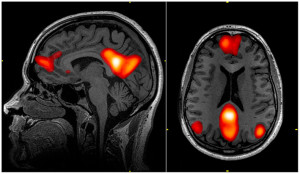 Previous posts on meditation described a brain circuit that becomes active when there is no focus on specific tasks, such as in daydreaming and before and after sleep. Research shows that this network, called either default mode network (DMN) or default network (DN), is stronger after meditation practice. The DN is a circuit active when not focusing on specific tasks, or internal concentration. There are now five of these default circuits described related to vision, memory, attention, movement and hearing.
Previous posts on meditation described a brain circuit that becomes active when there is no focus on specific tasks, such as in daydreaming and before and after sleep. Research shows that this network, called either default mode network (DMN) or default network (DN), is stronger after meditation practice. The DN is a circuit active when not focusing on specific tasks, or internal concentration. There are now five of these default circuits described related to vision, memory, attention, movement and hearing.
Rest brings about increased association activity in many brain regions—gathering information without specifically thinking. This downtime, also known as mind wandering or daydreaming, brings in new information about understanding experiences from happenings in the environment and internal thinking. Meditation appears to work by strengthening the regions and connectivity of the DN.
In day dreaming, wide ranging information is synthesized. Studies show that when doing simple activities without thought (dish washing), DN works to solve problems unconsciously. In fact, activities not requiring thought help solve problems more than deliberate thinking (see post on Meditation Update), because other brain associations are used in the decision making.
 This DN process works better in creative people, such as eureka moments, where solutions come during distractions from focused thought. Day dreaming helps this process by allowing wide associations from many brain regions.
This DN process works better in creative people, such as eureka moments, where solutions come during distractions from focused thought. Day dreaming helps this process by allowing wide associations from many brain regions.
The previous post noted that DN appears to inhibit brain regions related to focus and likewise focus decreases DN. There appears to be brief shifts between these two states, which might be basic to memory itself—alternation of focus and association. Meditation seems to increase both, making creativity and decision making stronger. Meditation not only strengthens the DN (associations) and focus, but increases the amount of brain gyrus, which corresponds to connectivity, increases the hippocampus, and the frontal cortex.
States of Mind
 William James first described the modern view of stream of consciousness with a series of thought events, each with a different pace. Spontaneous thoughts can seem to fly through many topics and then can stay focused on only one. The focused thoughts can be repetitive inner speech, worries and imaginary ideas. The flights can be creative. With renewed interest in concentration, mental focus, cognitive states and study of meditation, neuroscience of mind wandering is again being studied with modern techniques after a long lapse.
William James first described the modern view of stream of consciousness with a series of thought events, each with a different pace. Spontaneous thoughts can seem to fly through many topics and then can stay focused on only one. The focused thoughts can be repetitive inner speech, worries and imaginary ideas. The flights can be creative. With renewed interest in concentration, mental focus, cognitive states and study of meditation, neuroscience of mind wandering is again being studied with modern techniques after a long lapse.
Until recently, most psychology experiments weeded out thoughts not related to a particular task or goal, considered to be “noise”. States were compared to an ill-defined period of “rest” in between the tasks being studied. These rest periods constituted “noise” in the experiment. However, more recently it was found that during rest periods of mental activity, specific brain regions became more active—most notably memory and reasoning. Thus, it was learned that during rest the DN is more active during rest than during the focused tasks.
This discovery of the DN altered research, but still a dogma continues to interfere with this research. Mind wandering was still considered to be the opposite of focused or stimulated thought, rather than two complementary parts of a larger whole. It has been popularly defined in research as shifting attention from the focused task to a particular external stimulus. Some have assumed that the content of the mind wandering can define it, rather than understanding that it is a different mental state, not necessarily a differences of specific thought contents. In the terms of William James, mind wandering would be still be defined as one of two states—focused or a random thought. This definition, used widely in research, misses perhaps the essential aspect of mind wandering—that is, the transitions from one type of thought to another.
Some tentative definitions:
Thought: mental states and their transitions
Mental State: Thought or feeling with a particular content that relates to an individual’s behavior such as perceiving, remembering, or believing.
 Task-unrelated thoughts: content not related to current activity
Task-unrelated thoughts: content not related to current activity
Daydreaming: Thoughts unrelated to exact reality, may be imaginary or focusing on a view of a particular topic
Dreaming: Dreams are largely audio visual experiences including goals and recent experiences. Lucid dreaming is directed but other dreaming is not.
Creativity: Combination of free association and focus toward a goal. Putting together new thoughts with a goal.
Dynamics of Thought
 Considering the dynamics of how thoughts arise and change might lead to a better understanding than the particular contents of thoughts or stimulation. Mind wandering and rumination appear to be similar in that they are unrelated to a specific stimulus or current activity. But, mind wandering is free and changeable and rumination is not. Rumination is stuck in one theme of thoughts and feelings. Mind wandering might be related to possible future goals as well as specific tasks at hand
Considering the dynamics of how thoughts arise and change might lead to a better understanding than the particular contents of thoughts or stimulation. Mind wandering and rumination appear to be similar in that they are unrelated to a specific stimulus or current activity. But, mind wandering is free and changeable and rumination is not. Rumination is stuck in one theme of thoughts and feelings. Mind wandering might be related to possible future goals as well as specific tasks at hand
Thoughts can arise without a particular content and can change at any time to other content. Spontaneous thought can be altered by using the control of focus and concentration (cognitive control)—such as focusing on boring school work assignments. This type of direction on the free spontaneous thoughts are called constraints. Focusing with cognitive control is flexible because thought is brought back to the focus if it wanders (the same with meditation practice).
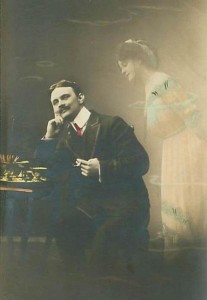 There are other forces that hold attention (constraints) to a particular information or thoughts. One is emotional concerns about our personal life, or something physical bothering us in the room such as a buzzing fly.
There are other forces that hold attention (constraints) to a particular information or thoughts. One is emotional concerns about our personal life, or something physical bothering us in the room such as a buzzing fly.
There are many constraints on our spontaneous thinking in a continuum. Mind wandering can be deliberately focused at any point (applying a constraint such as thinking about writing an article or song). Dreaming cannot. Creativity is more goal directed as is specific creative planning. Mind wandering as we said above is also different from rumination and obsessions.
Brain Circuits
 The DN has been observed to become inactive during focused tasks. But, in fact, DN is activated for quite a wide range of different internal mental states—not just spontaneous cognition. It is activated during focused internal thinking, meditation focused exercises, specifically thinking of a particular memory, thinking of our past history, and mentalizing, which is trying to understand what we think or what others think.
The DN has been observed to become inactive during focused tasks. But, in fact, DN is activated for quite a wide range of different internal mental states—not just spontaneous cognition. It is activated during focused internal thinking, meditation focused exercises, specifically thinking of a particular memory, thinking of our past history, and mentalizing, which is trying to understand what we think or what others think.
Among the many new circuits listed above that contribute to the total DN circuit, there are many large basic sub types.
I. The Core Subsystem of the DN appears to be the hub of a variety of related circuits. It is important in many kinds of internal thinking.
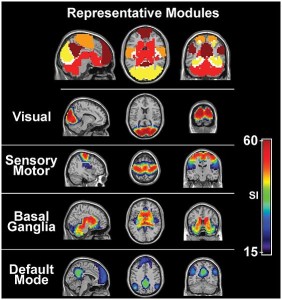 II. Another sub system are circuits in the medial temporal lobe DNN-MTL related to constructive mental simulations. These are putting together an imaginary future event from prior experiences.
II. Another sub system are circuits in the medial temporal lobe DNN-MTL related to constructive mental simulations. These are putting together an imaginary future event from prior experiences.
III. The third subsystem is not yet clearly defined but is a distinct subset of circuits. It is called DN-SUB3. It can be related to internal processing of emotions and concepts, as well as thinking about our own thought or others.
IV. Another circuit is related to attention to tasks in the external world (not just internal thinking). This is called Dorsal Attention Network or DAN. This circuit focuses on sensory input and connects with the movement that is triggered by this sensory information. This circuit is involved with keeping the concentration and focus on the specific situation and not allowing it to move as in spontaneous thought.
 The previous post on meditation discussed how meditation increases creativity by alternating between focus and free association, making both of them more efficient. In this current research view, the DN and DAN alternate and even dampen each other when there are shifts from focusing on the internal mental state and the external situation. Several different kinds of studies have seen these interactions including fMRIs during different mental activities including rest and measurement of neuronal groups in seizure patients. But, the full extent of this antagonism is not yet clear.
The previous post on meditation discussed how meditation increases creativity by alternating between focus and free association, making both of them more efficient. In this current research view, the DN and DAN alternate and even dampen each other when there are shifts from focusing on the internal mental state and the external situation. Several different kinds of studies have seen these interactions including fMRIs during different mental activities including rest and measurement of neuronal groups in seizure patients. But, the full extent of this antagonism is not yet clear.
V. and VI. One way the shift can occur is when something new, unexpected or meaningful happens in the external environment. Another circuit directs the focus to this new external happening—the ventral attention network of VAN. There is yet another ill-defined circuit that deals with anything meaningful, either internal or external, (Salience Network) and this travels through the anterior insula. The relationship between these two networks is not clear—whether these are one or two networks.
VII.  Conscious decisions change the focus also (deliberate cognitive control). This type of change relates to a circuit called the frontoparietal control network or FPCN. This is related to focus, attention or seeking a goal in either internal and external thinking. Both the FPCN and the DN signal together with focused internal thinking such as planning for future events or thinking about autobiographical issues. The opposite occurs with planning that involves external events where the FPCN works with the DAN. This FPCN therefore seems to be central to other networks.
Conscious decisions change the focus also (deliberate cognitive control). This type of change relates to a circuit called the frontoparietal control network or FPCN. This is related to focus, attention or seeking a goal in either internal and external thinking. Both the FPCN and the DN signal together with focused internal thinking such as planning for future events or thinking about autobiographical issues. The opposite occurs with planning that involves external events where the FPCN works with the DAN. This FPCN therefore seems to be central to other networks.
VIII. and IX. Another way that thought can focus is about thinking about time through current, recent, and distant events. This seems to involve another circuit as cingulo-opercular control network (COCN). The COCN seems to come into play, when there is an attempt to maintain a focus of thought and planning over a longer time. Just to make this more complicated another circuit seems to connect the COCN and PFCN. This is in the rostrolateral pre frontal cortex (rlPFC).
There are other brain regions where several of these circuits work together. These regions are in the border of the temporal and parietal lobes of the cortex, a gyrus in the inferior parietal, and the operculum (mentioned above in the COCN).
Content of Mind Wandering
 There are variety of types of thoughts and each could involve different circuits. One type is about a perception. A second are thoughts related to a current task or goal. Another is a particular type of sensation such as a sound or image. A factor is the meaning of the thought and its magnitude. Another dimension is the continuum of time with thoughts about the distant or near past, the present, and the near or distant future.
There are variety of types of thoughts and each could involve different circuits. One type is about a perception. A second are thoughts related to a current task or goal. Another is a particular type of sensation such as a sound or image. A factor is the meaning of the thought and its magnitude. Another dimension is the continuum of time with thoughts about the distant or near past, the present, and the near or distant future.
Until recently, most research has focused on how content changes during mind wandering when a particular activity is occurring. This research tries to find out how much of the time we are in mind wandering when we are supposedly doing something specific. In normal daily activities of living, the amount of mind wandering from the task at hand is a third to half of the time. With simple activities that don’t require much thought, it is greater (driving a car, washing dishes). Also the DN is more activated. fMRI studies find that the easier the activity the more DN is working. Also, this occurs during activity that is well known and much less for new tasks.
But, these studies did not distinguish between thoughts that were just unrelated, or those that had no relation to any specific stimulus. The most recent research shows that DN is involved in both.
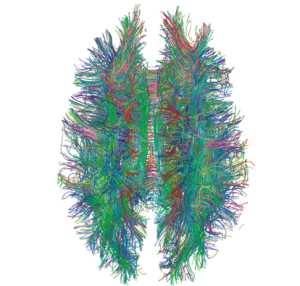
When analyzing just thoughts that are unrelated to the situation or task at hand, the FPCN and the lateral PFC are highly correlated. fMRI shows lateral PFC when resting even from the very early research. Lateral pre frontal cortex is correlated with planning and decision making and is involved with thought that is focused and directed. It is not clear what its relation is to thoughts unrelated to planning and specific tasks, and particularly to thoughts when at rest doing nothing.
One theory is that unrelated thoughts occur when unable to focus on the task at hand and the executive lateral PFC is brought in to stop the unrelated thoughts and go back to the task. Recent research doesn’t support this, however. One finding is that those who have greater working memory for better planning have even more unrelated thoughts when the tasks are not complex. One study of easy tasks is watching the breath in meditation. Another problem is that with aging there are more unrelated thoughts as well. TCS transcranial stimulation also increases unrelated thoughts. All of these should do the opposite if this suppression theory is correct.
 A different theory is that the executive circuits increase unrelated thoughts as they relate to underlying particular goals. Part of this theory is that these executive circuits stop sensory input during these unrelated thoughts. This allows an internal use of thoughts for goals without interruption from the environment. EEG research supports this view with less sensory input during unrelated thought. Other studies show less sound and images activity in the cortex with unrelated thought compared to focused thought. Also the DN is activated in posterior cingulate and the sensory motor regions are decreased. The problem with this theory is comparing unrelated thought with other types of interior thought. Task unrelated thought can be based on external not internal thoughts.
A different theory is that the executive circuits increase unrelated thoughts as they relate to underlying particular goals. Part of this theory is that these executive circuits stop sensory input during these unrelated thoughts. This allows an internal use of thoughts for goals without interruption from the environment. EEG research supports this view with less sensory input during unrelated thought. Other studies show less sound and images activity in the cortex with unrelated thought compared to focused thought. Also the DN is activated in posterior cingulate and the sensory motor regions are decreased. The problem with this theory is comparing unrelated thought with other types of interior thought. Task unrelated thought can be based on external not internal thoughts.
Different research has conflated three areas: unrelated thoughts, thoughts unrelated to sensory data, and internal thoughts. They are not really the same. But, do these help define mind wandering?
What is Spontaneous Thought
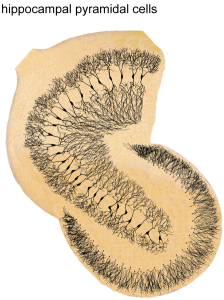 Only some of the DN networks appear to be related to spontaneous thought. Most parts of the DN are active during some versions of thoughts unrelated to a task and internal thinking. The DN-MTL seems to be more related to situations when unrelated thoughts occur without much awareness of a task. This seems to be closer to spontaneous thought. The MTL appears to activate during spontaneous thoughts and memories in research in humans and mice.
Only some of the DN networks appear to be related to spontaneous thought. Most parts of the DN are active during some versions of thoughts unrelated to a task and internal thinking. The DN-MTL seems to be more related to situations when unrelated thoughts occur without much awareness of a task. This seems to be closer to spontaneous thought. The MTL appears to activate during spontaneous thoughts and memories in research in humans and mice.
During rest, the MTL and the circuits of the hippocampus (memory) and cortex stimulate specific neurons. The same neurons seem to fire when thinking about a film later spontaneously that fired during the film. In mice during rest, place cells fire replaying routes and thoughts of future routes. MTL also occurs when advanced meditators notice wandering thoughts. Those people who have more mind wandering have more active MTL circuits in general.
Hippocampus is part of the MTL, which also is correlated with imagining, thinking of new situations, experiences and places. Together this type of research implies that the hippocampus is more than a memory center, but might be a center of hypothetical future thoughts. Current theory of memory is that it consists of clusters of neurons in varied parts of the MTL and cortex. These can fire together orchestrated by the hippocampus re-creating an experience.
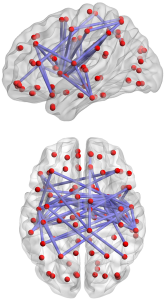 This theory and research goes along with the view that these clusters of neurons that fire to re-experience a memory are altered by goals, focus, and attention from the neo cortex.
This theory and research goes along with the view that these clusters of neurons that fire to re-experience a memory are altered by goals, focus, and attention from the neo cortex.
If this is correct, then it is possible that the hippocampus stimulates new thoughts by activating these clusters in various ways. Mental states would change with a change of the clusters. There would be a focus on a cluster and then a transition to another set of thoughts and experiences. The FPCN would operate by controlling some of these transitions. The rlPFC and DLPFC alter the focus on time especially for internal thoughts or abstract thoughts. This can affect the transition on limiting a focus on high level thoughts—creatively thinking about writing a paper for school. Other regions constrain the movement in various types of focus. Different circuits direct spontaneous thoughts in particular directions—time, meaning, planning.
When the mind is conscious of directing thoughts, executive regions are operating. For other focus of the spontaneous activity, these many circuits are involved.
Psychiatric Illness
 This theoretical framework has begun to be applied to psychiatric illness. In mental illness, spontaneous thoughts can be too much or too little. Spontaneous thoughts increase when there are less of the controls mentioned above.
This theoretical framework has begun to be applied to psychiatric illness. In mental illness, spontaneous thoughts can be too much or too little. Spontaneous thoughts increase when there are less of the controls mentioned above.
In depression there is rumination—repetitive negative thinking without much spontaneity and it is not voluntary. DN is increased in depression as are the circuits for meaning (salience). This involves mood circuits controlling the movement of these clusters. Depressed patients have increased connections of circuits in DN and decreased FPCN. FPCN is also not working with DAN with more internal experiences over external. This theory is that depression has a bias towards internal thought rather than external.
Anxiety also has repetitive negative thoughts with added intensity of worry and fear. They are similar to depression in some ways but greater responses to a threat. These respond even before the stimulus is understood. Subcortical regions enter the circuits in anxiety such as the amygdala and increased connections with FPCN. There is reduced relation to circuits of meaning. They have more connectivity with ventral striatum (habit learning) and subgenual anterior cingulate cortex (depression has less).
ADHD has increased spontaneous thought and variability. Lack of attention might relate to increased thoughts unrelated to tasks. There are circuits with decreased constraints on the circuits with decreased FPCN and DAN and a DN that doesn’t stop. The DAN and DN have weaker circuits in ADHD. Some studies show weaker subsets of the DN such as increase in MTL but less in the others. There is less deliberate and automatic direction of the neuronal experience clusters. One theory is inability to stop internal thoughts of DN.
Psychosis includes decreased executive abilities. They can be repetitive and rigid and excessive spontaneous thoughts. There are reductions in the meaning circuits and the DN. There may be less of a distinction of internal and external thought. In fact, there are many types of psychosis.
The Science of Mind Wandering
 Recent research is possibly beginning to clarify many interrelated mental states such as meditation, day dreaming, creativity, and mind wandering and how they relate to focus, goals, meaning, attention, and time.
Recent research is possibly beginning to clarify many interrelated mental states such as meditation, day dreaming, creativity, and mind wandering and how they relate to focus, goals, meaning, attention, and time.
The alternation of focus and mind wandering appears to be important for many mental functions. There is no doubt that some forms of mind wandering can be productive and that meditation helps strengthen this process.
As more brain circuits are understood, perhaps useful material can be learned about the nature of thought. There is no current reason to believe, however, that this will explain what thought is.